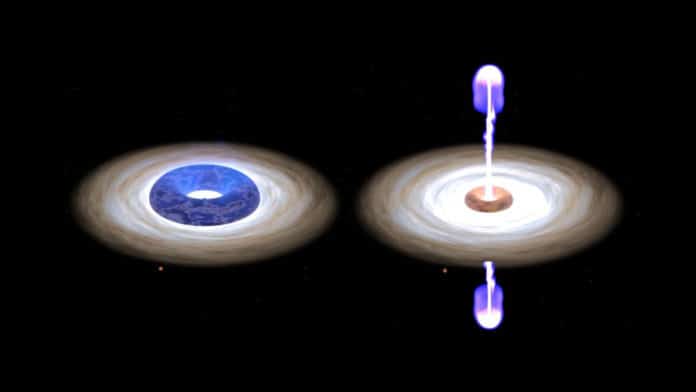Another source of radiation near a black hole is the corona. They are made of highly energetic particles that generate X-ray light. For twenty years, there has been a debate about whether the corona and the jet of the black hole were simply the same things.
In 2015, observations from NASA’s Explorer missions Swift and the Nuclear Spectroscopic Telescope Array, or NuSTAR, suggest that supermassive black holes send out jets when their surrounding coronas shoot, or launch, away from the black holes.
A new study by an international team of astronomers resolves a long open question in black hole science. They created a heartbeat graph of a black hole and a star orbiting around each other. The results that as material flows toward the black hole via its surrounding accretion disk, the black hole first heats the material in a so-called corona, and only after that does it emit jets.
Principal investigator Mariano Méndez (Kapteyn Institute, University of Groningen, the Netherlands) said, “It sounds logical, but there has been a debate for twenty years about whether the corona and the jet were simply the same things. Now we see that they arise one after the other and that the jet follows from the corona. It was quite a challenge to demonstrate this sequential nature. We had to compare data of years with that of seconds and very high energies with very low ones.”
Astronomers observed 15 years of data from several telescopes. They mainly pointed at the black hole GRS 1915+105 from space every three days and collected high-energy X-ray radiation from the corona.
Located about 36,000 light-years away from the Sun, the black hole is a stellar-mass black hole locked in a close binary system with another object and feeding off it. It is just 12 times the mass of the Sun.
Astronomers collected x-ray and radio data on the microquasar collected between 1996 and 2012 and studied it carefully for clues. They determined a strong correlation between (i) the radio flux that comes from the jet and the flux of the iron emission line that comes from the disk and (ii) the temperature of the hard X-ray corona and the amplitude of a high-frequency variability component that comes from the innermost part of the accretion flow.
They found that when X-ray light is strong, radio is weak, and vice versa, the jets are strongest when the corona is at its smallest.
The study shows that the energy that powers this black hole system can be directed in different proportions, mainly to the X-ray corona or the jet.
Despite the fact that scientists have proven the sequence, there are still some unanswered questions. For example, the X-ray radiation that the telescopes collect from the corona contains more energy than can be explained by the corona’s temperature alone.
According to scientists, a magnetic field provides extra energy. This magnetic field and the accompanying energy could also explain why jets are formed. If the magnetic field is chaotic, the corona heats up. If the magnetic field becomes less chaotic, the material can escape via the field lines into a jet.
Scientists suggest that the newly demonstrated principle may also apply to heavier black holes.
Journal Reference:
- Méndez, M., Karpouzas, K., García, F. et al. Coupling between the accreting corona and the relativistic jet in the microquasar GRS 1915+105. Nat Astron (2022). DOI: 10.1038/s41550-022-01617-y
